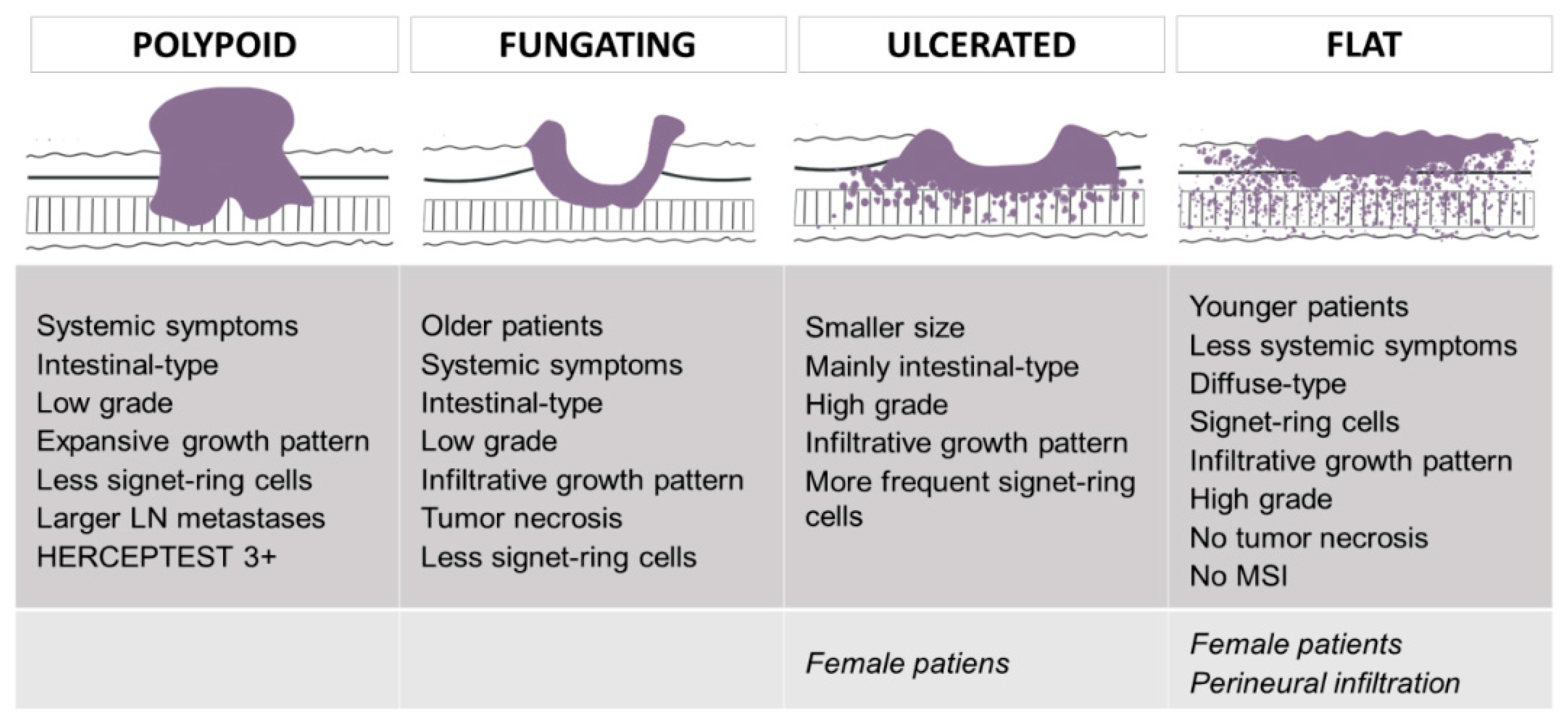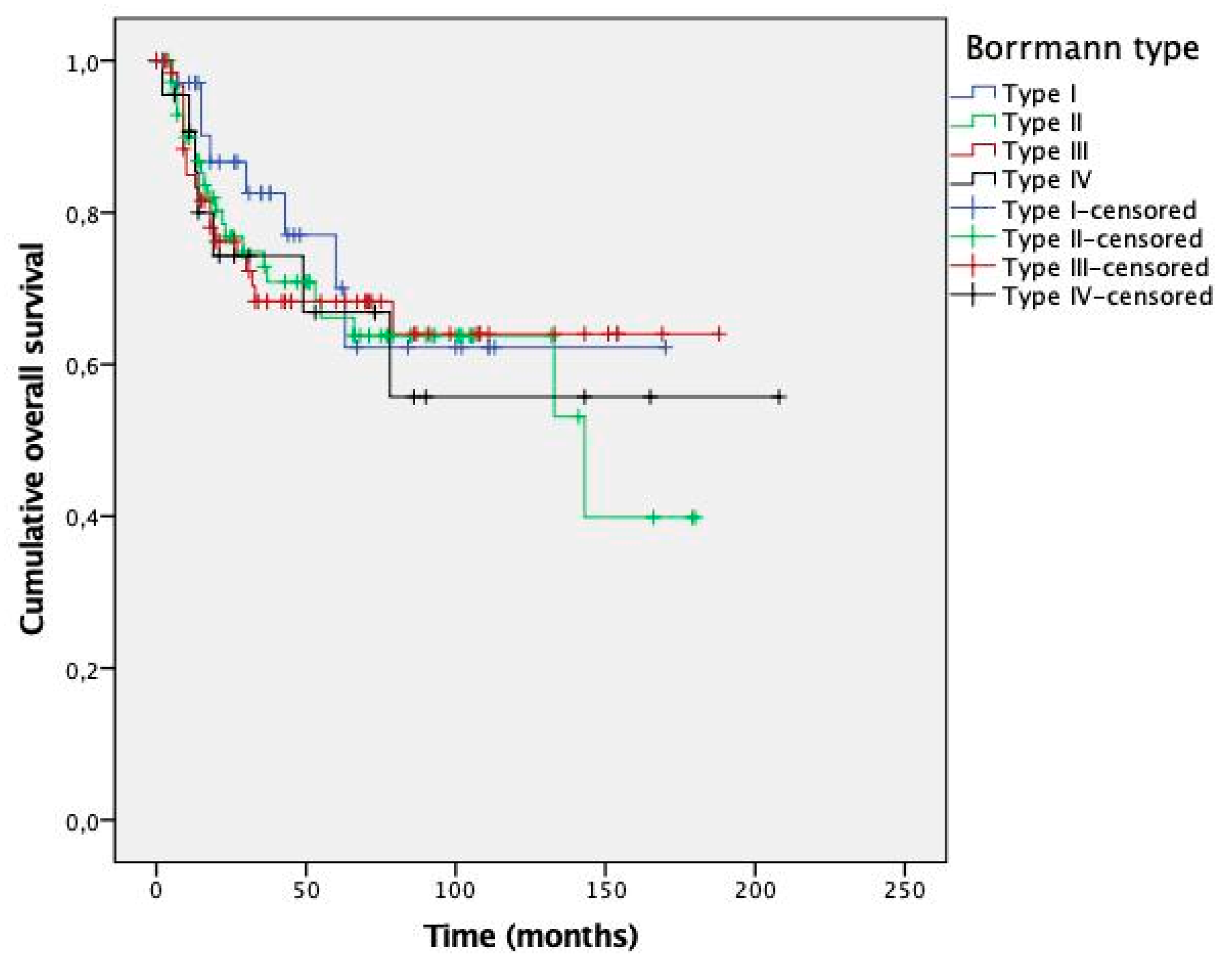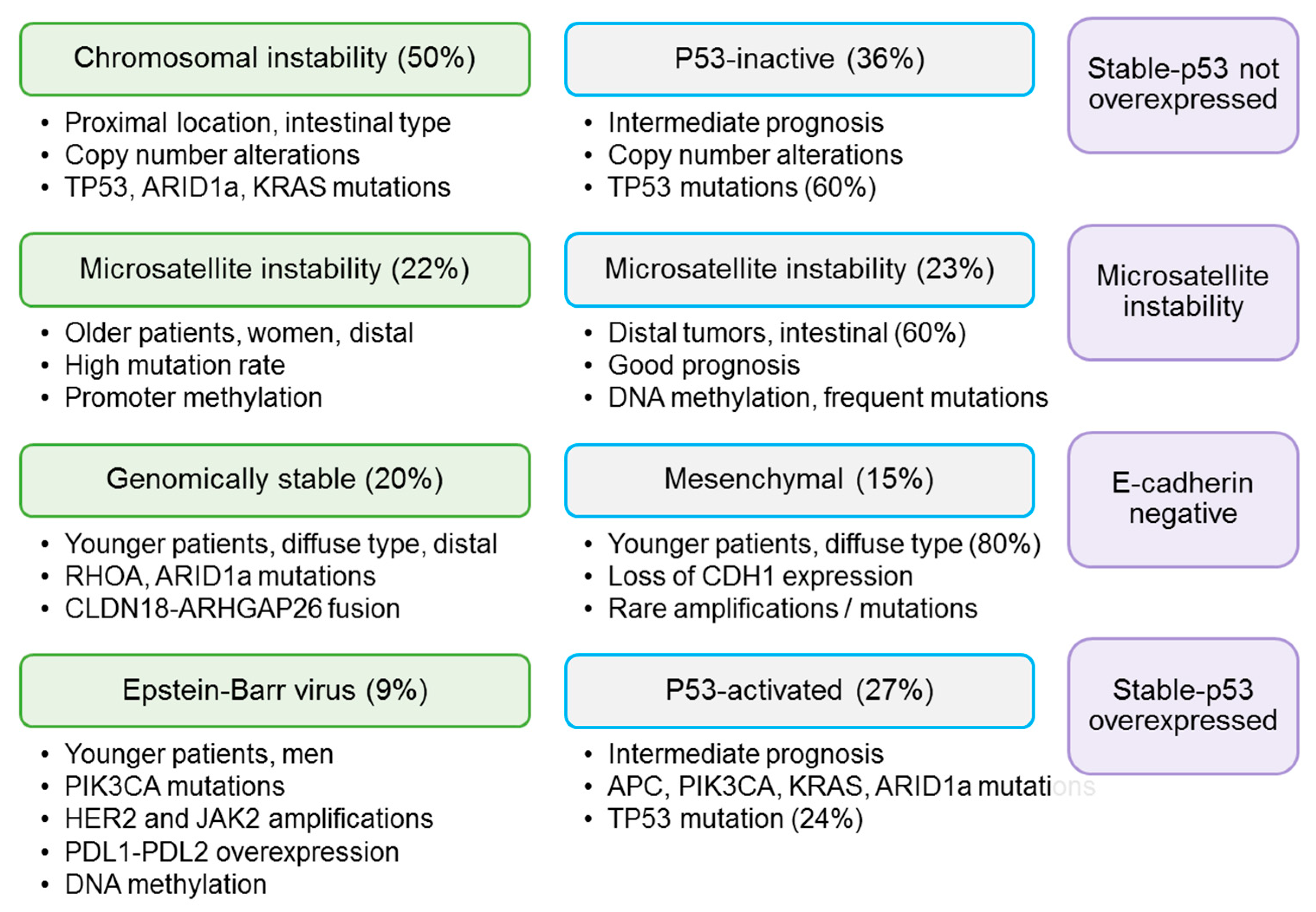Are Borrmann’s Types of Advanced Gastric Cancer Distinct Clinicopathological and Molecular Entities? A Western Study
Abstract
Simple Summary
Abstract
1. Introduction
2. Materials and Methods
2.1. Inclusion Criteria
2.2. Histopathological Study
2.3. Immunohistochemical Study
2.4. Statistical Analysis
3. Results
3.1. Clinicopathological and Molecular Features Associated with Borrmann Types
3.2. Prognostic Features
3.2.1. Prognostic Features of Our Cohort
3.2.2. Prognostic Role of the Borrmann Classification
4. Discussion
5. Strengths and Limitations of Our Study
6. Conclusions
Supplementary Materials
Author Contributions
Funding
Institutional Review Board Statement
Informed Consent Statement
Data Availability Statement
Acknowledgments
Conflicts of Interest
References
- Gao, J.P.; Xu, W.; Liu, W.T.; Yan, M.; Zhu, Z.G. Tumor heterogeneity of gastric cancer: From the perspective of tumor-initiating cell. World J. Gastroenterol. 2018, 24, 2567–2581. [Google Scholar] [CrossRef]
- Rawla, P.; Barsouk, A. Epidemiology of gastric cancer: Global trends, risk factors and prevention. Prz. Gastroenterol. 2019, 14, 26–38. [Google Scholar] [CrossRef]
- Shah, M.A.; Ajani, J.A. Gastric cancer-An enigmatic and heterogeneous disease. JAMA J. Am. Med. Assoc. 2010, 303, 1753–1754. [Google Scholar] [CrossRef] [PubMed]
- Ho, S.W.T.; Tan, P. Dissection of gastric cancer heterogeneity for precision oncology. Cancer Sci. 2019, 110, 3405–3414. [Google Scholar] [CrossRef] [PubMed]
- Hu, B.; Hajj, N.E.; Sittler, S.; Lammert, N.; Barnes, R.; Meloni-Ehrig, A. Gastric cancer: Classification, histology and application of molecular pathology. J. Gastrointest. Oncol. 2012, 3, 251–261. [Google Scholar] [PubMed]
- Bass, A.J.; Thorsson, V.; Shmulevich, I.; Reynolds, S.M.; Miller, M.; Bernard, B.; Hinoue, T.; Laird, P.W.; Curtis, C.; Shen, H.; et al. Comprehensive molecular characterization of gastric adenocarcinoma. Nature 2014, 513, 202–209. [Google Scholar] [CrossRef]
- Cristescu, R.; Lee, J.; Nebozhyn, M.; Kim, K.M.; Ting, J.C.; Wong, S.S.; Liu, J.; Yue, Y.G.; Wang, J.; Yu, K.; et al. Molecular analysis of gastric cancer identifies subtypes associated with distinct clinical outcomes. Nat. Med. 2015, 21, 449–456. [Google Scholar] [CrossRef] [PubMed]
- Lin, X.; Zhao, Y.; Song, W.M.; Zhang, B. Molecular classification and prediction in gastric cancer. Comput. Struct. Biotechnol. J. 2015, 13, 448–458. [Google Scholar] [CrossRef]
- Cho, I.; Kwon, I.G.; Guner, A.; Son, T.; Kim, H.I.; Kang, D.R.; Noh, S.H.; Lim, J.S.; Hyung, W.J. Consideration of clinicopathologic features improves patient stratification for multimodal treatment of gastric cancer. Oncotarget 2017, 8, 79594–79603. [Google Scholar] [CrossRef][Green Version]
- Kanda, M.; Murotani, K.; Tanaka, H.; Miwa, T.; Umeda, S.; Tanaka, C.; Kobayashi, D.; Hayashi, M.; Hattori, N.; Suenaga, M.; et al. A novel dual-marker expression panel for easy and accurate risk stratification of patients with gastric cancer. Cancer Med. 2018, 7, 2463–2471. [Google Scholar] [CrossRef]
- Han, S.L.; Hua, Y.W.; Wang, C.H.; Ji, S.Q.; Zhuang, J. Metastatic pattern of lymph node and surgery for gastric stump cancer. J. Surg. Oncol. 2003, 82, 241–246. [Google Scholar] [CrossRef]
- Li, C.; Oh, S.J.; Kim, S.; Hyung, W.J.; Yan, M.; Zhu, Z.G.; Noh, S.H. Macroscopic borrmann type as a simple prognostic indicator in patients with advanced gastric cancer. Oncology 2009, 77, 197–204. [Google Scholar] [CrossRef] [PubMed]
- Borrmann, R.; Henke, F.; Lubarsch, O. Handbuch der Speziellen Pathologischen Anatomic und Histologie; Springer: Berlin, Germany, 1926; Volume 4, p. 865. [Google Scholar]
- Amin, M.; Edge, S.; Greene, F.; Byrd, D.; Brookland, R.; Washington, M.; Gershenwald, J.; Compaton, C.; Hess, K. AJCC Cancer Staging Manual, 8th ed.; Springer International Publishing: Berlin, Germany, 2017. [Google Scholar]
- Lucas, F.A.M.; Cristovam, S.N. HER2 testing in gastric cancer: An update. World J. Gastroenterol. 2016, 22, 4619–4625. [Google Scholar]
- Díaz del Arco, C.; Estrada Muñoz, L.; Molina Roldán, E.; Cerón Nieto, M.Á.; Ortega Medina, L.; García Gómez de las Heras, S.; Fernández Aceñero, M.J. Immunohistochemical classification of gastric cancer based on new molecular biomarkers: A potential predictor of survival. Virchows Arch. 2018, 473, 687–695. [Google Scholar] [CrossRef] [PubMed]
- Lambert, R. The Paris endoscopic classification of superficial neoplastic lesions: Esophagus, stomach, and colon-November 30 to December 1, 2002. Gastrointest. Endosc. 2003, 58, S3–S43. [Google Scholar]
- Sano, T.; Kodera, Y. Japanese classification of gastric carcinoma: 3rd English edition. Gastric Cancer 2011, 14, 101–112. [Google Scholar] [CrossRef]
- Yook, J.H.; Oh, S.T.; Kim, B.S. Clinicopathological Analysis of Borrmann Type IV Gastric Cancer. Cancer Res. Treat. 2005, 37, 87. [Google Scholar] [CrossRef] [PubMed]
- Zhu, Y.-L.; Yang, L.; Sui, Z.-Q.; Liu, L.; Du, J.-F. Clinicopathological features and prognosis of Borrmann type IV gastric cancer-PubMed. J. BUON 2016, 21, 1471–1475. [Google Scholar] [PubMed]
- Kim, D.Y.; Kim, H.R.; Kim, Y.J.; Kim, S.K. Clinicopathological features of patients with Borrmann type IV gastric carcinoma. ANZ J. Surg. 2002, 72, 739–742. [Google Scholar] [CrossRef]
- Luo, Y.; Gao, P.; Song, Y.; Sun, J.; Huang, X.; Zhao, J.; Ma, B.; Li, Y.; Wang, Z. Clinicopathologic characteristics and prognosis of Borrmann type IV gastric cancer: A meta-analysis. World J. Surg. Oncol. 2016, 14, 1–9. [Google Scholar] [CrossRef]
- Dai, X.; Zhang, X.; Yu, J. Clinicopathological features and Borrmann classification associated with HER2-positive in primary gastric cancer. Clin. Exp. Gastroenterol. 2019, 12, 287–294. [Google Scholar] [CrossRef] [PubMed]
- Lee, H.S.; Choi, S.I.; Lee, H.K.; Kim, H.S.; Yang, H.K.; Kang, G.H.; Il Kim, Y.I.; Lee, B.L.; Kim, W.H. Distinct clinical features and outcomes of gastric cancers with microsatellite instability. Mod. Pathol. 2002, 15, 632–640. [Google Scholar] [CrossRef] [PubMed]
- Kim, H.; An, J.Y.; Noh, S.H.; Shin, S.K.; Lee, Y.C.; Kim, H. High microsatellite instability predicts good prognosis in intestinal-type gastric cancers. J. Gastroenterol. Hepatol. 2011, 26, 585–592. [Google Scholar] [CrossRef] [PubMed]
- Miceli, R.; An, J.; Di Bartolomeo, M.; Morano, F.; Kim, S.T.; Park, S.H.; Choi, M.G.; Lee, J.H.; Raimondi, A.; Fucà, G.; et al. Prognostic Impact of Microsatellite Instability in Asian Gastric Cancer Patients Enrolled in the ARTIST Trial. Oncology 2019, 97, 38–43. [Google Scholar] [CrossRef]
- Lai, Y.C.; Yeh, T.S.; Wu, R.C.; Tsai, C.K.; Yang, L.Y.; Lin, G.; Kuo, M.D. Acute tumor transition angle on computed tomography predicts chromosomal instability status of primary gastric cancer: Radiogenomics analysis from TCGA and independent validation. Cancers 2019, 11, 641. [Google Scholar] [CrossRef] [PubMed]
- An, J.Y.; Kang, T.H.; Choi, M.G.; Noh, J.H.; Sohn, T.S.; Kim, S. Borrmann type IV: An independent prognostic factor for survival in gastric cancer. J. Gastrointest. Surg. 2008, 12, 1364–1369. [Google Scholar] [CrossRef]
- Zhai, Z.; Zhu, Z.Y.; Zhang, Y.; Yin, X.; Han, B.L.; Gao, J.L.; Lou, S.H.; Fang, T.Y.; Wang, Y.M.; Li, C.F.; et al. Prognostic significance of Borrmann type combined with vessel invasion status in advanced gastric cancer. World J. Gastrointest. Oncol. 2020, 12, 992–1004. [Google Scholar] [CrossRef]
- Huang, J.Y.; Wang, Z.N.; Lu, C.Y.; Miao, Z.F.; Zhu, Z.; Song, Y.X.; Xu, H.M.; Xu, Y.Y. Borrmann type IV gastric cancer should be classified as pT4b disease. J. Surg. Res. 2016, 203, 258–267. [Google Scholar] [CrossRef]
- Kim, J.H.; Lee, H.H.; Seo, H.S.; Jung, Y.J.; Park, C.H. Borrmann Type 1 Cancer is Associated with a High Recurrence Rate in Locally Advanced Gastric Cancer. Ann. Surg. Oncol. 2018, 25, 2044–2052. [Google Scholar] [CrossRef]
- Kuo, C.Y.; Chao, Y.; Li, C.P. Update on treatment of gastric cancer. J. Chin. Med. Assoc. 2014, 77, 345–353. [Google Scholar] [CrossRef]
- Karimi, P.; Islami, F.; Anandasabapathy, S.; Freedman, N.D.; Kamangar, F. Gastric cancer: Descriptive epidemiology, risk factors, screening, and prevention. Cancer Epidemiol. Biomark. Prev. 2014, 23, 700–713. [Google Scholar] [CrossRef] [PubMed]
- Etemadi, A.; Safiri, S.; Sepanlou, S.G.; Ikuta, K.; Bisignano, C.; Shakeri, R.; Amani, M.; Fitzmaurice, C.; Nixon, M.R.; Abbasi, N.; et al. The global, regional, and national burden of stomach cancer in 195 countries, 1990–2017: A systematic analysis for the Global Burden of Disease study 2017. Lancet Gastroenterol. Hepatol. 2020, 5, 42–54. [Google Scholar] [CrossRef]
- Kim, E.Y.; Yoo, H.M.; Song, K.Y.; Park, C.H. Limited significance of curative surgery in Borrmann type IV gastric cancer. Med. Oncol. 2016, 33, 1–7. [Google Scholar] [CrossRef] [PubMed]
- Song, X.H.; Zhang, W.H.; Liu, K.; Chen, X.L.; Zhao, L.Y.; Chen, X.Z.; Yang, K.; Zhou, Z.G.; Hu, J.K. Prognostic impact of Borrmann classification on advanced gastric cancer: A retrospective cohort from a single institution in western China. World J. Surg. Oncol. 2020, 18. [Google Scholar] [CrossRef]
- Liang, C.; Chen, G.; Zhao, B.; Qiu, H.; Li, W.; Sun, X.; Zhou, Z.; Chen, Y. Borrmann Type IV Gastric Cancer: Focus on the Role of Gastrectomy. J. Gastrointest. Surg. 2020, 24, 1026–1032. [Google Scholar] [CrossRef]




| Feature | n (Valid %), N = 260 Mean (SD a) | |
|---|---|---|
| Age (years) | 72 (12) | |
| Men | 156 (54.9%) | |
| Smoking | Former | 28 (10.9%) |
| Ex-smoker | 64 (24.8%) | |
| Drinking | Former | 24 (9.3%) |
| Ex-drinker | 11 (4.3%) | |
| Symptoms | Symptomatic | 191 (73.5%) |
| Local | 133 (64.3%) | |
| Systemic | 120 (58%) | |
| Size (mm) | 47 (23) | |
| Depth (mm) | 10 (4) | |
| Macroscopic type | Polypoid | 45 (18.7%) |
| Fungating | 94 (39%) | |
| Ulcerated | 78 (32.4%) | |
| Flat | 24 (10%) | |
| Location | Cardia | 5 (2.1%) |
| Fundus | 17 (7.2%) | |
| Body | 85 (36.2%) | |
| Antrum | 128 (54.4%) | |
| Tumor grade (high) | 132 (52.8%) | |
| Necrosis | 64 (24.6%) | |
| Vascular invasion | 119 (42.3%) | |
| Perineural infiltration | 114 (43.9%) | |
| Growth pattern (infiltrative) | 134 (64.1%) | |
| Budding | 30 (23.4%) | |
| Desmoplasia | 98 (49.7%) | |
| Intratumoral II b | Mild | 42 (20.5%) |
| High | 137 (66.8%) | |
| Peritumoral II | 65 65 (31.4%) | |
| MSI | 57 (31.7%) | |
| HERCEPTEST | 0 | 162 (92%) |
| 1+ | 7 (4%) | |
| 2+ | 4 (2.3%) | |
| 3+ | 3 (1.7%) | |
| Molecular subtype c | Type 1 | 45 (25.4%) |
| Type 2 | 11 (6.2%) | |
| Type 3 | 90 (50.8%) | |
| Type 4 | 31 (17.5%) | |
| T stage | T2 | 60 (23.1%) |
| T3 | 152 (58.5%) | |
| T4 | 48 (18.5%) | |
| N stage | N0 | 82 (32.5%) |
| N1 | 48 (19%) | |
| N2 | 58 (23%) | |
| N3 | 64 (25.4%) | |
| TNM stage | I | 36 (14.3%) |
| II | 90 (35.7%) | |
| III | 126 (50%) | |
| Lymph node ratio | 0.22 (0.27) | |
| Gastrectomy | Subtotal | 182 (71.4%) |
| Total | 73 (28.6%) | |
| Lymphadenectomy | D1 | 33 (12.7%) |
| D2 | 69 (26.5%) | |
| NS | 156 (60.8%) | |
| Adjuvant therapy | 44 (20%) | |
| Recurrence | 100 (41.7%) | |
| DFS d (mean, months, SD) | 40 (46) | |
| DFS (median, months) | 16 | |
| Death | 66 (30.4%) | |
| Overall survival (mean, months, SD) | 44 (45) | |
| Overall survival (median, months) | 27 | |
| Feature (Valid %) | Polypoid (1) | Fungating (2) | Ulcerated (3) | Flat (4) | p | |
|---|---|---|---|---|---|---|
| Age at diagnosis (years) | 70 | 77 | 71 | 62 | 0.001 | |
| Systemic symptoms | 71.40% | 65% | 49.20% | 38.90% | 0.032 | |
| Size (mm) | 51.7 | 53.5 | 30 | 48.5 | 0.001 | |
| Laurén | Intestinal | 66.70% | 73.10% | 48.70% | 25% | <0.001 |
| Diffuse | 31.10% | 18.30% | 35.50% | 66.70% | ||
| Mixed | 2.20% | 8.60% | 15.80% | 8.30% | ||
| Signet-ring cells | 28.90% | 25.80% | 43.60% | 62.50% | 0.002 | |
| Infiltrative growth pattern | 45% | 65.30% | 65.10% | 90.90% | 0.004 | |
| High grade | 47.70% | 37.50% | 61.80% | 79.20% | <0.001 | |
| Tumor necrosis | 22.20% | 34% | 23% | 0% | 0.006 | |
| Largest LN a metastasis | 15 | 11 | 9 | 6 | 0.002 | |
| MSI b | 35.10% | 35% | 38.20% | 0% | 0.016 | |
| HERCEPTEST | Negative | 91.40% | 98.30% | 96.30% | 95.50% | 0.036 |
| 2+ | 0% | 1.70% | 3.70% | 4.50% | ||
| 3+ | 8.60% | 0% | 0% | 0% | ||
| Molecular subtype c | Type 1 | 31.40% | 23.70% | 34.50% | 0% | <0.001 |
| Type 2 | 2.90% | 11.90% | 3.60% | 0% | ||
| Type 3 | 60% | 35.60% | 49.10% | 86.40% | ||
| Type 4 | 5.70% | 28.80% | 12.70% | 13.60% | ||
| Sex (male) | 60% | 61.70% | 41.60% | 43.50% | 0.051 | |
| Perineural infiltration | 37.80% | 40.40% | 46.20% | 66.70% | 0.097 | |
| Tumor Recurrence | |||
|---|---|---|---|
| Feature | OR (95% CI) | p | |
| Signet-ring cells | 1.94 (1.14–3.32) | 0.014 | |
| Laurén | Intestinal | 1 | 0.004 |
| subtype | Diffuse | 2.59 (1.46–4.58) | |
| Mixed | 1.14 (0.45–2.92) | ||
| Perineural infiltration | 1.93 (1.14–3.24) | 0.013 | |
| Vascular invasion | 2.16 (1.28–3.66) | 0.004 | |
| T stage | T2 | 1 | 0.012 |
| T3 | 2.09 (1.1–4.12) | ||
| T4 | 3.49 (1.49–8.2) | ||
| Lymph node metastasis | 2.96 (1.58–5.54) | <0.001 | |
| Lymph node ratio | 0.19 | ||
| TNM stage | I | 1 | <0.001 |
| II | 2.8 (1–8.03) | ||
| III | 6.78 (2.45–18.81) | ||
| Tumor grade | 1.61 (0.96–2.72) | 0.076 | |
| Cancer-specific death | |||
| Feature | OR (95% CI) | p | |
| Signet-ring cells | 1.96 (1.08–3.55) | 0.026 | |
| Laurén | Intestinal | 1 | 0.015 |
| subtype | Diffuse | 2.51 (1.33–4.72) | |
| Mixed | 1.58 (0.55–4.54) | ||
| Vascular invasion | 2.16 (1.2–3.88) | 0.01 | |
| Growth pattern | 2.52 (1.17–5.39) | 0.016 | |
| Desmoplasia | 0.48 (0.24–0.94) | 0.032 | |
| T stage | T2 | 1 | 0.006 |
| T3 | 2.06 (0.92–4.65) | ||
| T4 | 4.54 (1.75–11.79) | ||
| Lymph node metastasis | 3.6 (1.7–7.63) | 0.001 | |
| Lymph node ratio | <0.001 | ||
| TNM stage | I | 1 | <0.001 |
| II | 4.34 (0.94–20.04) | ||
| III | 10.44 (2.36–46.17) | ||
| Tumor grade | 1.79 (0.98–3.27) | 0.058 | |
| Dependent Variable | Factor | p | HR (95% CI) | |
|---|---|---|---|---|
| Tumor recurrence | Laurén subtype | Intestinal | 0.016 | |
| Diffuse | 0.008 | 1.796 (1.167–2.763) | ||
| Mixed | 0.790 | 0.901 (0.420–1.934) | ||
| TNM stage | I | 0.001 | ||
| II | 0.050 | 2.602 (1–6.767) | ||
| III | 0.001 | 4.627 (1.815–11.793) | ||
| Vascular invasion | 0.006 | 1.840 (1.195–2.835) | ||
| Cancer-specific death | Laurén subtype | Intestinal | 0.022 | |
| Diffuse | 0.007 | 2.453 (1.281–4.696) | ||
| Mixed | 0.615 | 1.297 (0.471–3.568) | ||
| TNM stage | I | 0.033 | ||
| II | 0.132 | 3.132 (0.709–13.823) | ||
| III | 0.022 | 5.416 (1.270–23.091) | ||
| Type I | Type II | Type III | Type IV | p | |
|---|---|---|---|---|---|
| Recurrence | 42.2% | 37.2% | 39.7% | 56% | 0.411 |
| Death | 24.3% | 31.8% | 28.4% | 32.4% | 0.825 |
| Type I | Type II | Type III | Type IV | |
|---|---|---|---|---|
| DFS a (mean, 95% CI b) | 87 (60–113) | 98 (78–119) | 106 (85–128) | 76 (41–112) |
| OS c (mean, 95% CI) | 120 (91–149) | 113 (93–134) | 128 (106–150) | 131 (86–176) |
Publisher’s Note: MDPI stays neutral with regard to jurisdictional claims in published maps and institutional affiliations. |
© 2021 by the authors. Licensee MDPI, Basel, Switzerland. This article is an open access article distributed under the terms and conditions of the Creative Commons Attribution (CC BY) license (https://creativecommons.org/licenses/by/4.0/).
Share and Cite
Díaz del Arco, C.; Ortega Medina, L.; Estrada Muñoz, L.; Molina Roldán, E.; Cerón Nieto, M.Á.; García Gómez de las Heras, S.; Fernández Aceñero, M.J. Are Borrmann’s Types of Advanced Gastric Cancer Distinct Clinicopathological and Molecular Entities? A Western Study. Cancers 2021, 13, 3081. https://doi.org/10.3390/cancers13123081
Díaz del Arco C, Ortega Medina L, Estrada Muñoz L, Molina Roldán E, Cerón Nieto MÁ, García Gómez de las Heras S, Fernández Aceñero MJ. Are Borrmann’s Types of Advanced Gastric Cancer Distinct Clinicopathological and Molecular Entities? A Western Study. Cancers. 2021; 13(12):3081. https://doi.org/10.3390/cancers13123081
Chicago/Turabian StyleDíaz del Arco, Cristina, Luis Ortega Medina, Lourdes Estrada Muñoz, Elena Molina Roldán, M. Ángeles Cerón Nieto, Soledad García Gómez de las Heras, and M. Jesús Fernández Aceñero. 2021. "Are Borrmann’s Types of Advanced Gastric Cancer Distinct Clinicopathological and Molecular Entities? A Western Study" Cancers 13, no. 12: 3081. https://doi.org/10.3390/cancers13123081
APA StyleDíaz del Arco, C., Ortega Medina, L., Estrada Muñoz, L., Molina Roldán, E., Cerón Nieto, M. Á., García Gómez de las Heras, S., & Fernández Aceñero, M. J. (2021). Are Borrmann’s Types of Advanced Gastric Cancer Distinct Clinicopathological and Molecular Entities? A Western Study. Cancers, 13(12), 3081. https://doi.org/10.3390/cancers13123081






